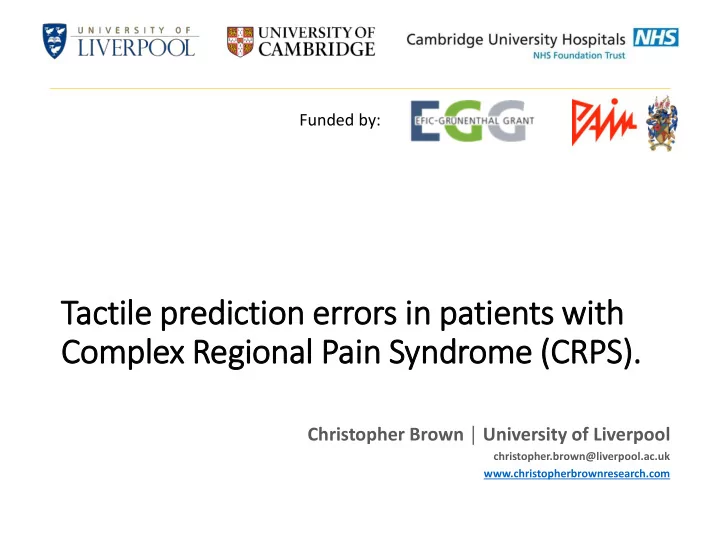

Funded by: Tactile prediction errors in in patients wit ith Complex Regional Pain Syndrome (C (CRPS). Christopher Brown │ University of Liverpool christopher.brown@liverpool.ac.uk www.christopherbrownresearch.com
Complex Regional Pain Syndrome (CPRS) CRPS has variable signs and symptoms – a diagnosis of exclusion Pathophysiology is complex and variable between patients A range of biomarkers are needed to support patient stratification and improve diagnostic certainty Bruehl S. Anesthesiology . 2010;113(3):713-725.
Tactile-spatial processing in the brain Somatosensory homunculus Grey matter density (Geha et al., 2008) - fMRI studies find no difference - Smaller in CRPS > HC in anterior insula (AI) / vmPFC e.g. Mancini et al. 2018 Late-latency somatosensory Tactile “mismatch” responses - Reciprocal insula-S1 evoked potentials (SEPs) connections (Allen et al., 2016) - Larger in CRPS > HC when unexpected (Kuttikat et al., 2018)
The current study Aim To identify neural computations underlying larger responses to unexpected tactile stimuli in patients with CRPS vs. healthy controls (HCs), using a predictive coding model Predicting coding model: simplified Probability of The brain tries to predict sensory input inputs; must therefore contain Prediction Prediction representations of input probabilities error ε Sensory Larger “mismatch” responses are input ω thought to be prediction errors Greater uncertainty in ε 2 prediction increases the ω certainty (precision) of prediction error
Methods (CRPS n=22, HC n=22) Digit ring-electrode placement Block types Behavioral response to digit Change Distance (CD) change Change Probability (CP) (response time) CP = 10% CP = 10% CD = 1 CD = 3 CP = 30% CP = 30% CD = 1 CD = 3 Example stimulus sequence CP = 50% CP = 50% EEG D3 CD = 1 CD = 3 (somatosensory- D4 evoked potentials) Digit change (10%, 30% or 50% probability) No digit change (90%, 70% or 50% probability) Block order Hand (left, right) CP/CD condition
Uncertain prediction drives more precise prediction error in CRPS > HC group ω ε
Greater “mismatch” responses in CRPS partly explained by prediction error Whole EEG Partial EEG explained by prediction ε error
Questions for further research 1. Insula source of prediction error? Relation to insula atrophy? 2. Specificity to somatosensory spatial perception? 3. Specificity to patients with CRPS (vs. other chronic pain, fracture)? 4. Effects of medication? 5. Relation to peripheral symptoms/signs (e.g. autonomic, immune, inflammatory responses)?
The study team Dr Mike Lee Ingrid Scholtes Dr Nick Shenker
Recommend
More recommend